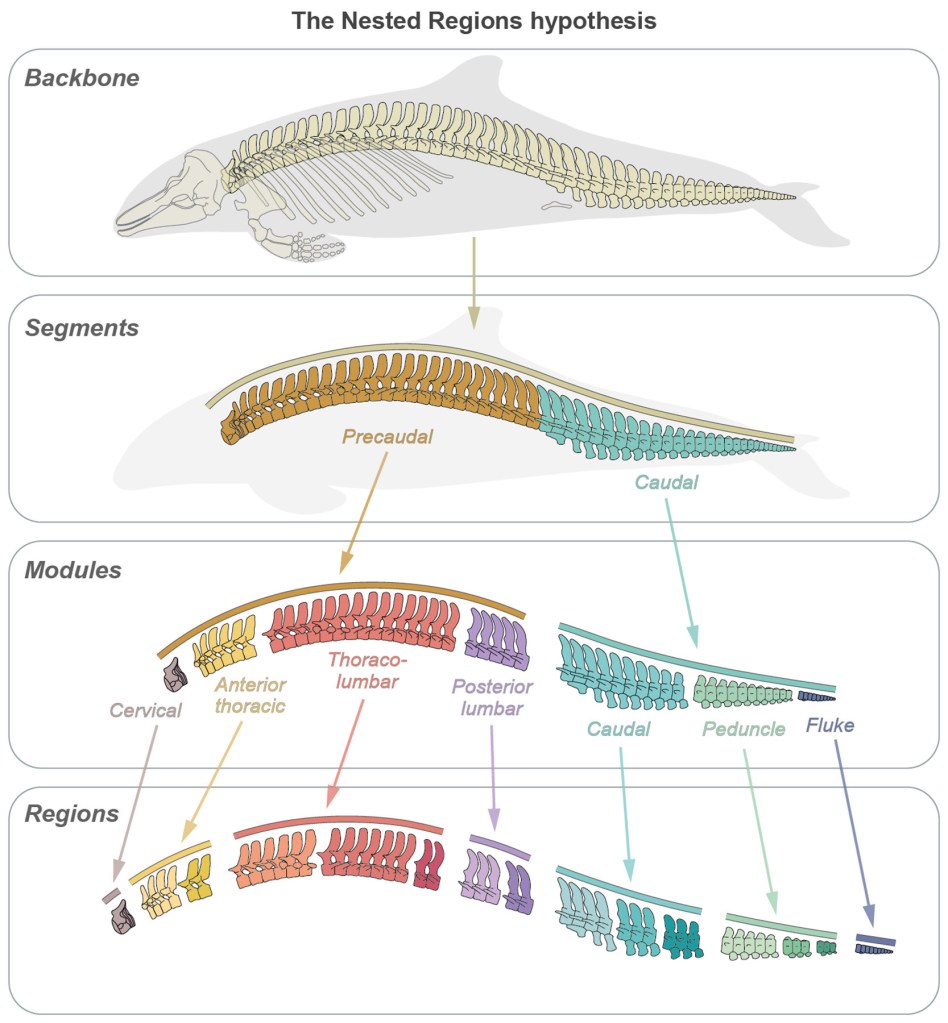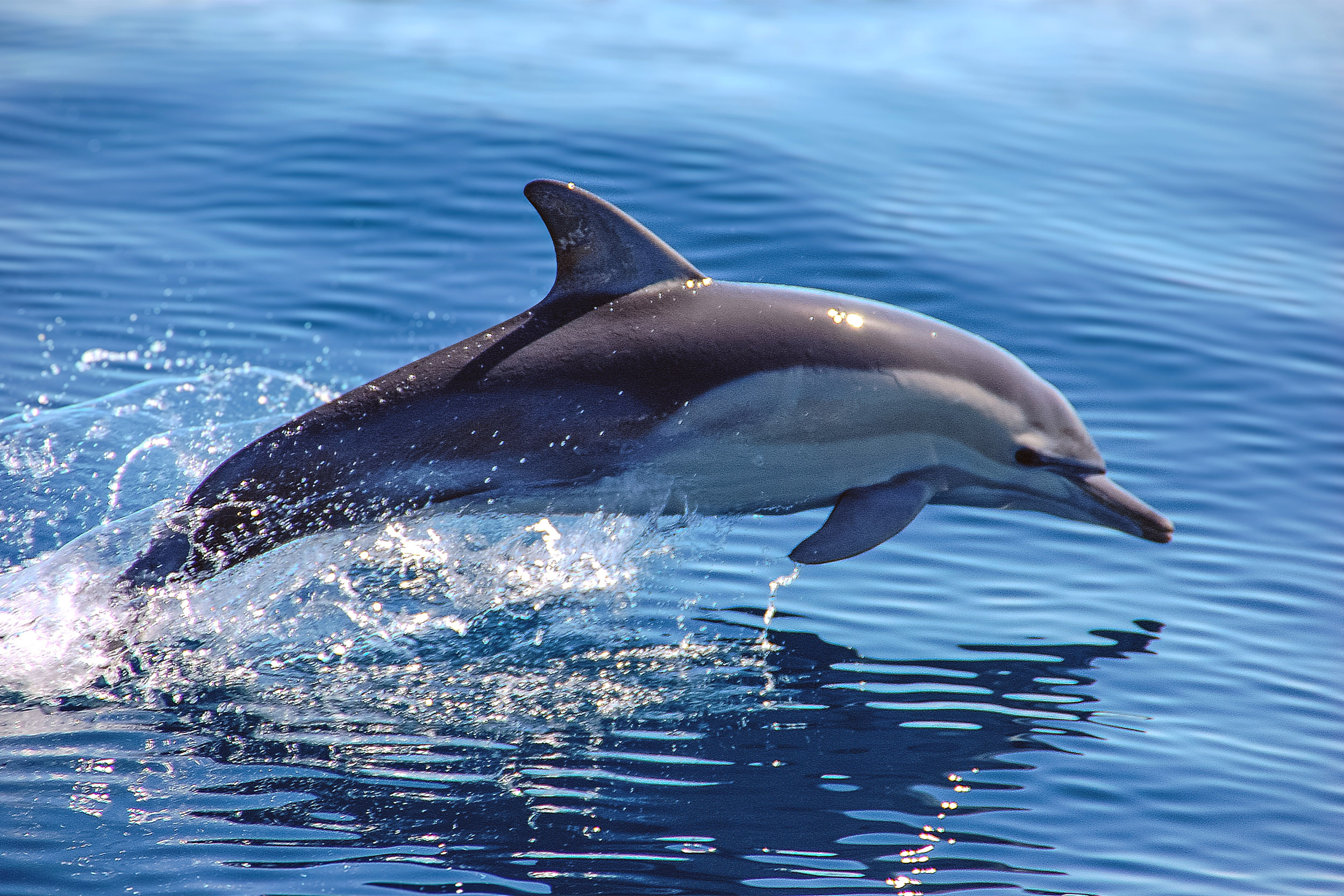If you’ve ever seen dolphins swim, you may have wondered why they undulate instead of moving side to side as fish do. Though they have a fishlike body, cetaceans, which include whales, dolphins, and porpoises, are mammals that descended from land-dwelling ancestors.
Cetaceans have undergone profound changes in their skeletal structures to thrive in aquatic environments, including the reduction of hindlimbs and the evolution of flippers and tail flukes, resulting in a streamlined body. Scientists still don’t understand how the transition from land to water, approximately 53 million years ago, impacted cetaceans’ backbone, a central element of their skeleton.
A new study in Nature Communications sheds light on how these marine mammals’ backbones were reorganized as their ancestors adapted to life in water. The international Harvard-led team found that, contrary to previous assumptions, the cetacean backbone is highly regionalized, despite being homogeneous in shape along its length. The way in the backbone is regionalized, however, is drastically different from terrestrial mammals.
The team also explored how regions in the backbone correlate to habitat and swimming speed. They discovered that species living farther from the coast have more vertebrae, more regions, and higher burst swimming speed. Species living in rivers and bays, so closer to shore, have fewer vertebrae and regions, but their regions differ more from one another, potentially affording them greater maneuverability.
“When their ancestor went back into the water, whales and dolphins lost their hind legs and developed a fish-like body,” said lead author Amandine Gillet, Marie Curie Fellow in the Department of Organismic and Evolutionary Biology at Harvard and in the Department of Earth and Environmental Sciences at the University of Manchester. “But that morphological change also means the vertebral column is now the main part of the skeleton driving locomotion in an aquatic environment.”
The vertebral column of terrestrial mammals moving on land must provide support to help the legs carry the body weight. When cetaceans transitioned from land to water, the forces of gravity shifted from air to buoyant water, releasing the pressure to carry body weight. The new body structure and movements needed to move through water meant the backbone of these animals would have to shift in some way to fit their new environments.
Previous studies have looked at the backbone from a vertebral morphological view. In a 2018 Science paper, co-authors Stephanie Pierce and Katrina Jones explored the complex evolutionary history of the mammalian backbone using a novel statistical method first developed to study the backbones of snakes. Pierce and Jones revised the model to fit their study, which allowed them to demonstrate that the vertebral column of terrestrial mammals is characterized by numerous, distinct regions in comparison to amphibians and reptiles.

Comparing backbones of species living in shallow waters (left) and the open ocean (right) shows differences in number of vertebrae, regions, and modules.
Credit: Amandine Gillet
“It’s a challenge to understand how the regions of a terrestrial mammal’s backbone can be found in whales and dolphins, and one reason is because their backbone looks very different in terms of morphology, even though they evolved from them,” said Pierce, a professor in the Department of Organismic and Evolutionary Biology at Harvard and senior author of the study. “They lost the sacrum, a fused string of vertebrae bracing the hind legs, and a critical landmark needed to distinguish the tail from the rest of the body.”
The vertebrae of cetaceans are further complicated in that they became more homogeneous in their anatomical features. So the transition from one vertebra to another is gradual compared to the extreme transitions found in terrestrial mammals, making it more difficult to identify regions.
“Not only do they have very similar vertebrae, but certain species, in particular porpoises and dolphins, have many more vertebrae than terrestrial mammals, with some species having close to 100 vertebrae,” said Jones. “This makes it really challenging to translate regions found in terrestrial mammals to the backbones in whales and dolphins.”
Traditional statistical methods used to identify regionalization patterns require the exact same number of elements across specimens. The statistical method Pierce and Jones implemented (called Regions) allowed them to overcome this issue by analyzing the backbone of each specimen individually. While the method worked well for the constrained backbone of terrestrial mammals, it proved computationally challenging for the high counts of vertebrae in cetaceans. Gillet collaborated with the Data Science Services team at the Harvard Institute for Quantitative Social Science to rewrite the code, allowing the program to obtain results within minutes. The researchers made the new program, called MorphoRegions, publicly available for the scientific community as a computational software R package.
“This is definitely one of the biggest advances of our study,” said Pierce. “Amandine spent months refining the program so that it could analyze a system of high repeating units without crashing the computer.”
Gillet applied the MorphoRegions method to the data she had previously collected during her Ph.D. work. She visited six museums in Europe, South Africa, and the U.S. gathering information on 139 specimens from 62 cetacean species, two-thirds of the almost 90 living species. In total, Gillet measured 7,500 vertebrae and ran them through the analytical pipeline.

Researchers propose a model where the backbone of cetaceans is divided into precaudal and caudal segments.
Credit: Amandine Gillet
“Our large data set allowed us to demonstrate that not only does the organization of the cetacean backbone differ from terrestrial mammals, but also that the patterns vary within cetaceans as we identified between six and nine regions depending on the species” said Gillet, “We then worked from there to find commonalities across regions and identified a pattern common to all cetaceans, which is summarized by our Nested Regions hypothesis.”
The hypothesis proposed by the team introduces a hierarchical organization of the backbone in which a precaudal and a caudal segment are first identified. The two segments are then each divided into several modules common to all cetaceans: cervical, anterior thoracic, thoraco-lumbar, posterior lumbar, caudal, peduncle, and fluke. Next, depending on the species, each module is further subdivided into one to four regions, with a minimum of six and a maximum of nine post-cervical regions along the backbone.
“Surprisingly, this showed us that, compared to terrestrial mammals, the precaudal segment has less regions, whereas the caudal area has more,” said Pierce. “Terrestrial mammals use their tails for a variety of different functions, but not usually for generating propulsive forces, like cetaceans do. Having more regions in the tail may allow for movement in very specific regions of the tail.”
With a better understanding of the organization of the cetacean backbone, the researchers plan to next tackle understanding how these morphological regions correlate with function using experimental data on the flexibility of the vertebral column collected in the lab. These data collected on modern taxa should allow the researchers to infer swimming abilities of fossil whales and help inform how the backbone shifted from a weight-bearing structure on land to a propulsion-generating organ in the water.
Source link

